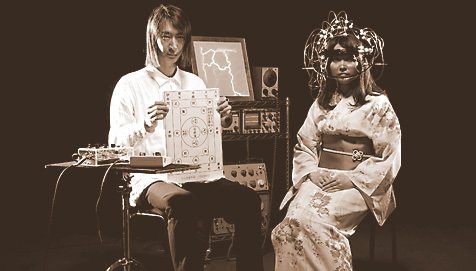
You’re about to learn a lot of cool things about Ghost frontman Masaki Batoh. It’s probably best to lay out the facts in bullet point form:
• In addition to fronting one of the great Japanese psych rock bands of our time and touring regularly, Batoh is a professional, working acupuncturist.
• Batoh commissioned a device called the Brain Pulse Music machine that essentially translates brain waves from the parietal and frontal lobes into sounds (and Batoh has mastered its use).
• Batoh has a new album, Brain Pulse Music coming out on Drag City February 28.
• Batoh is a badass who really cares about the people of his country.
• Watch this.
Brain Pulse Music (BPM) was originally meant to be a straightforward attempt to translate brain waves into sound for the purpose of creating music. Following the earthquake that hit Japan in March 2011, the project changed considerably. Once Batoh was able to return to his acupuncture practice, he noticed a distinct increase in the anxiety levels of his patients. Instead of just translating any old thoughts into sounds, Batoh’s mission shifted to translating the post-disaster mindset that he saw permeating society into music. By creating music out of the brain pulses within this framework, Batoh also sought to create a release valve to help relieve that newfound anxiety.
Here’s a little more info on the machine:
…[The BPM machine] consists of headgear and a motherboard. In order to see the immediate effects on the level of brain waves, a special set of goggles that project indicator lamps (synchronized with the motherboard) are worn during the performance of the recording session. The headgear is worn by the performer, which picks up brain waves from the parietal and frontal lobes and sends them, via radio waves, to the motherboard. The motherboard then converts the radio waves via a generator into wave pulses, which are then output as sound.
Needless to say, this is a very cool and intriguing idea that borders on science fiction. The intensity and emotion that the promotional video hints at is a good indicator of the heft that Batoh’s project brings to the table. While the tones that make up this music are electronic, the album finds Batoh releasing some of the most traditional folk-oriented music of his career, a reflection of the roots of where the electronic tones originated, the Japanese psyche.
Batoh is donating all proceeds from the album to the Japanese Red Cross in support of earthquake victims. If the concept at play here isn’t enough to get you to buy this, hopefully that should do it.
Brain Pulse Music tracklisting:
01. Kumano Codex 1: Shou (wind pipes) and Nambu Furin (bells)
02. Eye tracking test: BPM machines (2 machines at same time)
03. Kumano Codex 2: 9 people play Konchiki (small gong hit by dear horn
stick) walking in a circle
04. Kumano Codex 3: Kodaiko (small drum), Shakubyoshi, Hansho (Buddhist
gong), Kagura suzu (bells) and Shakuhachi (flute)
05. Kumano Codex 4: Odaiko (big drum) , Konchiki, Mokugyo (Buddhist wood
block), Hyoushi-gi (wood block) and Shakuhachi
06. Kumano Codex 5: Kin (Buddhist bells)
07. Aiki no Okami: BPM machines (2 machines), Plasma Thermin, Springer FX
and Norito (Shinto chant)
• Masaki Batoh: http://www.dragcity.com/artists/masaki-batoh
• Drag City: http://www.dragcity.com
• Japanese Red Cross: http://www.jrc.or.jp/english/index.html